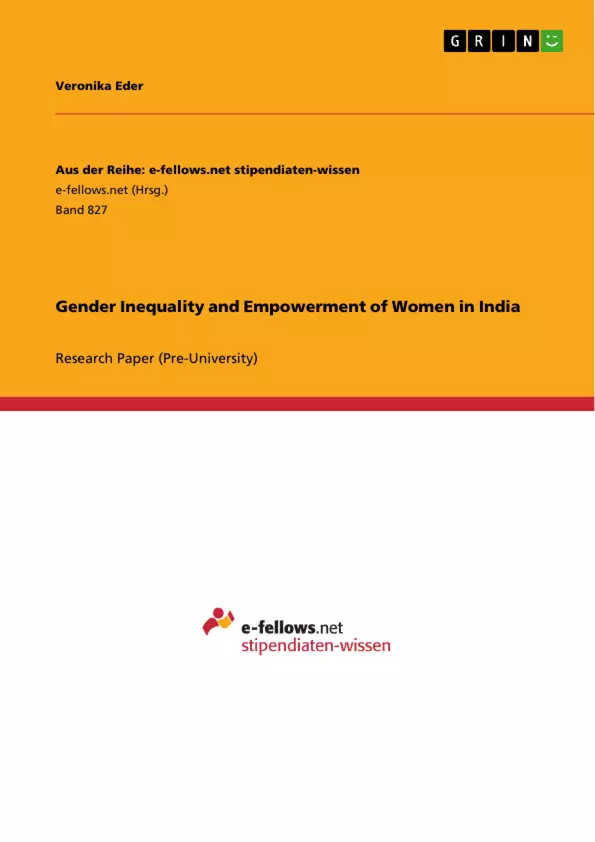In dieser Arbeit wird die Geschlechterrolle der Indischen Frauen bzw. deren Benachteiligung von verschieden Seiten beleuchtet.
Außerdem wird dargestellt, wie bzw. wer (Institutionen, Organisationen)in Zukunft dabei helfen kann und wird, indischen Frauen mehr Macht zu geben.
Inhaltsverzeichnis (Table of Contents)
- Introduction
- Gender Inequality
- Reasons for Gender Inequality
- Sectors of Distinction
- Economy
- Education
- Health and Survival
- Female Foeticide as a Practice of Gender Inequality
- Ultra-Sonography as a Pre-Natal Diagnostic Technique
- Consequences of Gender Inequality
- Bride Shortage
- Mental Disorders
- Empowerment of Women
- Political Empowerment
- Social Empowerment
- The Swayam Shikshan Prayog
- Childline Foundation India
- Economic Empowerment
- Conclusion
Zielsetzung und Themenschwerpunkte (Objectives and Key Themes)
This work aims to analyze the issue of gender inequality in India, exploring its roots, manifestations, and consequences. The author seeks to shed light on the challenges faced by women and highlight the ongoing efforts toward their empowerment. The key themes explored in the text include: * **The deep-rooted nature of gender inequality in Indian society:** The text examines traditional practices, cultural beliefs, and economic factors that contribute to gender disparities. * **The impact of gender inequality on various sectors:** The analysis focuses on how gender inequality manifests in the economy, education, and health, highlighting the disadvantages experienced by women. * **The importance of women's empowerment:** The work explores different approaches to empowering women, including political, social, and economic empowerment initiatives. * **The challenges and possibilities for improving the situation of women in India:** The text sheds light on the ongoing efforts to address gender inequality and the potential for positive change.Zusammenfassung der Kapitel (Chapter Summaries)
- Introduction: This chapter sets the stage by introducing the pervasive nature of gender inequality in India, highlighting the disparity in status, opportunities, and expectations between men and women. It emphasizes the need to understand the underlying reasons for this inequality.
- Gender Inequality: This chapter explores the various factors contributing to gender inequality, including societal norms, traditional beliefs, and economic structures. It delves into the concept of Dharma and its role in perpetuating gender disparities.
- Reasons for Gender Inequality: This chapter examines specific reasons for gender inequality, such as the preference for male children, the dowry system, and the economic disadvantages faced by women. It highlights the pervasive metaphor used to describe raising a girl child, emphasizing the deep-rooted prejudice against women.
- Sectors of Distinction: This chapter analyzes the impact of gender inequality across various sectors. It focuses on the economic challenges faced by women, including their lower wages, limited access to resources, and the phenomenon of the "feminization of poverty." The chapter also explores the gender disparities in education, highlighting the lower enrollment rates for girls and the lack of adequate facilities for their education.
- Economy: This chapter delves into the economic disadvantage experienced by women due to the double burden of "productive and reproductive activities." It examines the lack of recognition for women's labor and the barriers they face in accessing financial resources.
- Education: This chapter examines the gap in educational opportunities between boys and girls, highlighting the lower enrollment rates and attendance for girls. It explores the reasons behind this gap, including poverty, social expectations, and the lack of adequate infrastructure.
- Health and Survival: This chapter addresses the issue of child mortality in India, focusing on the disproportionate impact on girls. It explores the factors contributing to this disparity, such as gender bias in healthcare access and the practice of female foeticide.
Schlüsselwörter (Keywords)
This work focuses on the themes of gender inequality, women's empowerment, social structures, economic disparities, traditional practices, education, health, and development in the context of India. The text explores concepts like Dharma, dowry, female foeticide, ultra-sonography, and the "feminization of poverty."
Ende der Leseprobe aus 24 Seiten
- nach oben
- Arbeit zitieren
- Veronika Eder (Autor:in), 2012, Gender Inequality and Empowerment of Women in India, München, GRIN Verlag, https://www.grin.com/document/231294
Blick ins Buch



